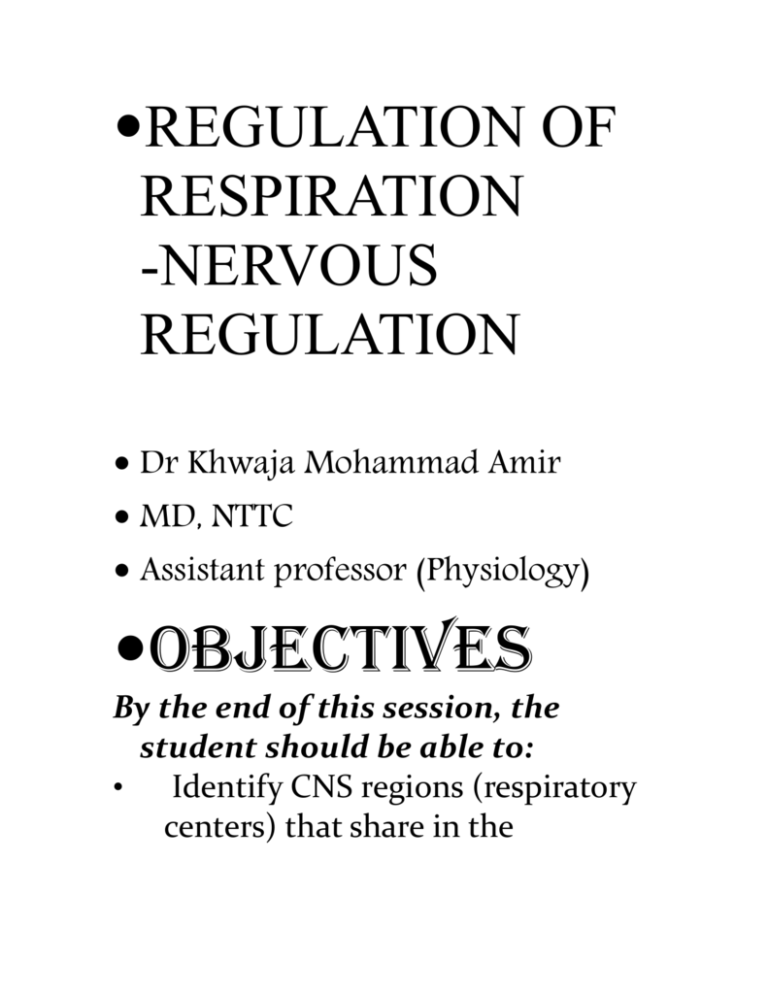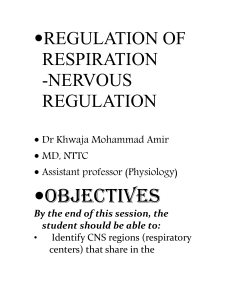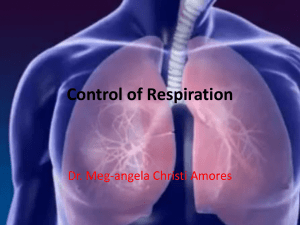Voluntary control of respiration
advertisement

REGULATION OF RESPIRATION -NERVOUS REGULATION Dr Khwaja Mohammad Amir MD, NTTC Assistant professor (Physiology) Objectives By the end of this session, the student should be able to: • Identify CNS regions (respiratory centers) that share in the • • • generation and control of cyclic breathing. Describe receptors and neural pathways of the reflexes involved in regulation of respiration The spontaneous respiration is regulated by two mechanisms Nervous Regulatory Mechanism Chemical Regulatory Mechanism Nervous Regulatory Mechanism • Automatic Control of Respiration Brainstem • Voluntary Control of Respiration Cerebral cortex • Automatic Control Of Respiration It is brought about by two centre located in the brainstem • • Medullary respiratory center Pontine respiratory center Medullary respiratory center It consists of two types of neurons – I neurons and E neurons that are active during inspiration and expiration only respectively. These neurons are located in two groups in the medulla • Dorsal respiratory group • Ventral respiratory group • Dorsal Respiratory Group- • Near Nucleus Tractus Solitarius Consists of primarily inspiratory(I) neurons Basic rhythm of respiration is generated here in the form inspiratory ramp signals. Receive afferents from airways and chemoreceptors • Ventral Respiratory Group- • Near nucleus ambigous and retroambigous. Inactive during normal quiet breathing Contributes to the extra respiratory drive. Inspiratory(I) and Expiratory(E) neurons have reciprocal innervations. Inspiratory Ramp Signal: • It begins weakly and then increases steadily in a ramp manner for about 2 seconds ,ceases abruptly for approx. 3 seconds which allows elastic recoil of the lungs and chest wall to cause expiration, and then another cycle begins. • The advantage of the ramp signal is that it causes a steady increase in the volume of the lungs during inspiration., rather than inspiratory gasps. Pontine Respiratory Center It is subdivided into two groups • Lower Pons- Called apneustic center Tonically active and activates the I neurons Inhibited by the afferents from the vagus nerve from airway and the lungs. • Upper Pons- Called Pneumotaxic center Contains both I and E neurons Active in both phases of respiration Inhibits neurons in lower pons. Thus rhytmicity of the neurons in the medullary respiratory center is spontaneous but it is modified by • Neurons in the Pons • Afferents in the vagus nerve from receptors in the lungs and airways. Voluntary control of respiration Acts through the corticospinal tract which originates from the cerebral cortex to end on the spinal motor neurons innervating the respiratory group of muscles. Thus this pathway bypasses the medullary respiratory neurons. Factors affecting respiratory center Hering-Breuer Inflation Reflex: • Steady inflation of the lungs stimulates the stretch receptors in the walls of bronchi and bronchioles, this in turn stimulates the vagus nerve. The vagus nerve then inhibits the apneustic centre thus switching off the inspiration . • This is a protective mechanism preventing excess inflation of the lungs. The threshold for this reflex is tidal volume more than 1.5 litres(T.V.≥1.5l) Afferent from pharynx trachea and bronchi-from trachea to bronchioles there are myelinated nerve endings of vagal fibres that function as Irritant Receptors. • Cough reflex-deep inspiration followed by a forced expiration against a closed glottis. The glottis is then suddenly opened producing an explosive outflow of air. • Sneezing reflex-it is a similar expiratory effort with a continuously open glottis. Swallowing or deglutition reflex- During swallowing movement respiration is inhibited(deglutition apnea). Afferent from glossopharyngeal nerve(IX) inhibits the respiration. This reflex is protective in nature and prevents aspiration of food particles into the respiratory tract. Hiccup –spasmodic contraction of diaphragm producing an inspiration during which glottis suddenly closes producing a sound. Afferent from Baroreceptors and Chemoreceptors: • Baroreceptors- Baroreceptors in carotid and aortic sinus get stimulated by high blood pressure and cause inhibition of respiration by inhibiting respiratory center. • Chemoreceptors- Chemoreceptors in aortic and carotid bodies get stimulated by low oxygen and high carbon dioxide. These impulses through vagus and glossopharyngeal nerve increase rate and depth of respiration. Summary • • Identify CNS regions (respiratory centers) that share in the generation and control of cyclic breathing. Describe receptors and neural pathways of the reflexes involved in regulation of respiration Thanks ……..









